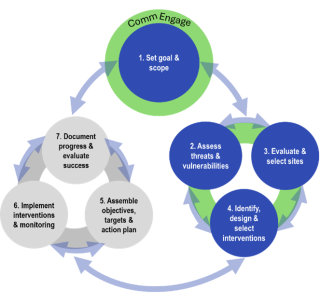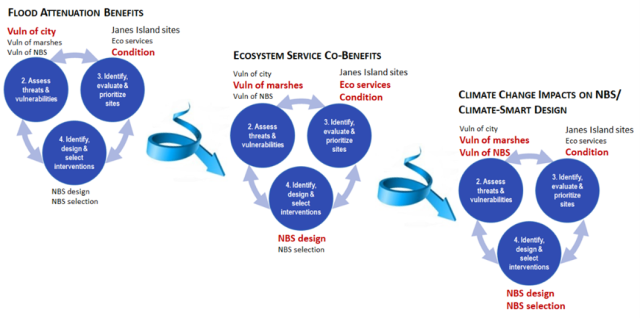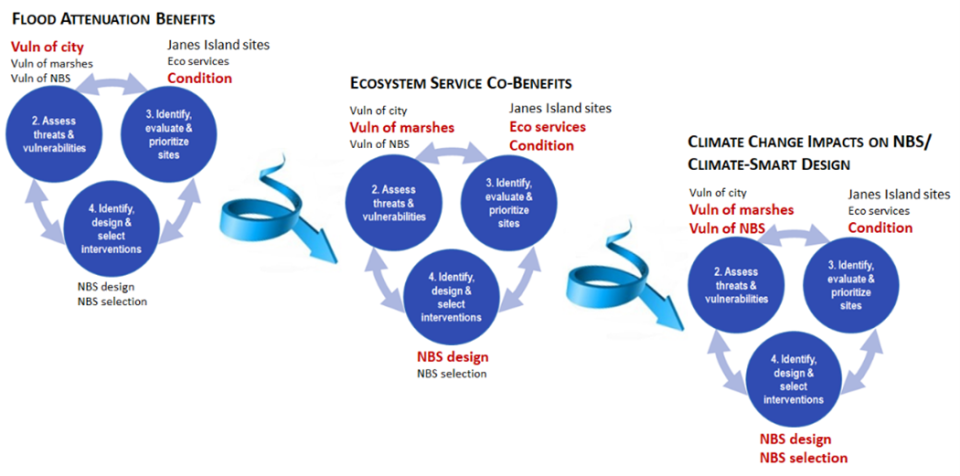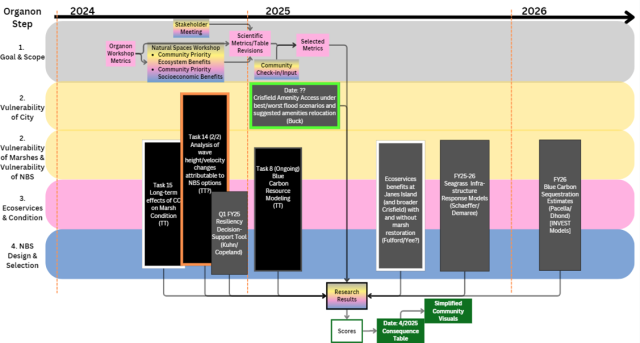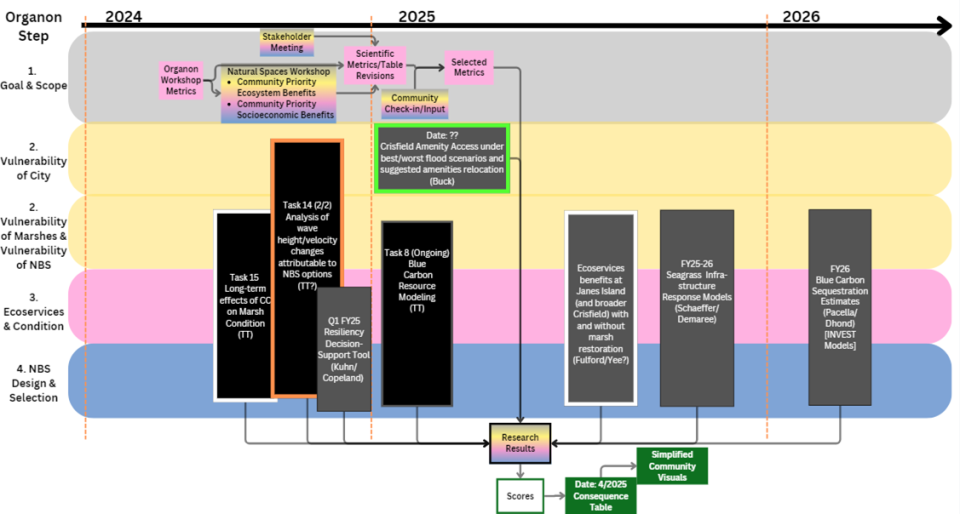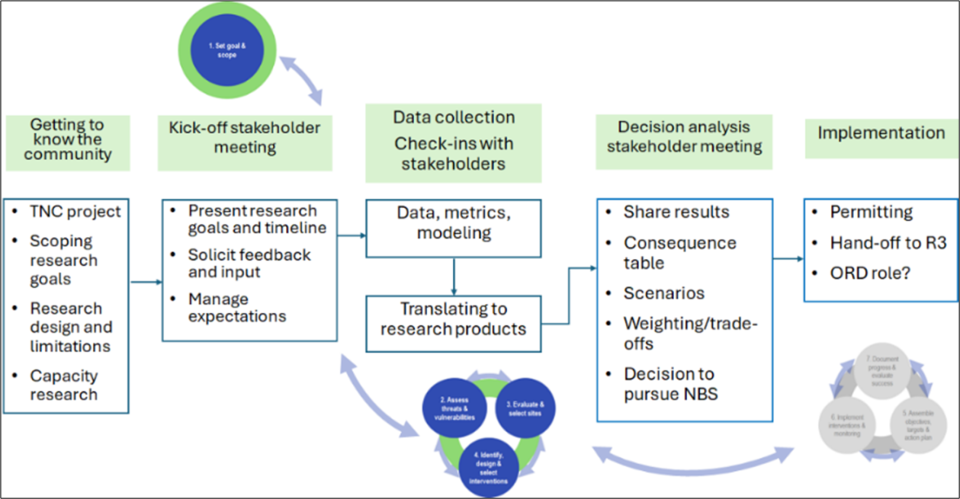Region 3 Chesapeake Bay Solutions-Driven Research Project
Quick Look 
Collaboration Goal:
Apply the Organon as a structured process for organizing, integrating, and synthesizing diverse components of EPA’s coastal community resilience solutions-driven research (SDR) to inform co-production of nature-based solutions (NBS) for coastal resilience in partnership with the city of Crisfield, Maryland.
Process:
Hold two internal workshops of the multidisciplinary EPA research team to:
- Integrate team members' research components into a combined assessment of NBS options (e.g., marsh restoration, living breakwaters) for storm surge and wave attenuation and other ecosystem service co-benefits.
- Iteratively assess the status, progress, and linkages among research components and develop timelines for completion and interweaving of results.
- Develop community engagement strategies for research co-production on goal setting, regular feedback on methods and preliminary results for incorporation into next steps, and decision support information for evaluating NBS options to implement.
Benefits to the Community:
- Improved coordination of EPA research on which NBS options have the greatest potential to serve the resilience needs of the community.
- Methods for evaluating NBS trade-offs in terms of effectiveness for storm surge and wave attenuation, provision of other co-benefits, feasibility, sustainability, etc.
- A downloadable NBS design assessment report and worksheets to inform NBS design for long term effectiveness and resilience.
Background
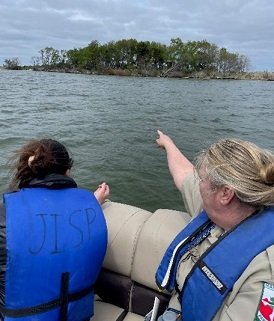
The community of Crisfield, Maryland (MD), faces significant environmental challenges due to sea level rise, intensifying storms, land subsidence, and associated flooding, which have direct impacts on the community’s people, property, and infrastructure. The Environmental Protection Agency’s (EPA) coastal community resilience solutions-driven research (SDR) project with Crisfield investigated the ability of nature-based solutions (NBS) (e.g., salt marshes, dunes, oyster reefs) to increase the resilience of the community to flooding, erosion, and other coastal issues. While the City pursues flood mitigation through gray infrastructure (e.g., tide gates and pumping stations), EPA research simultaneously advances complementary goals to protect and restore natural resources by exploring natural infrastructure NBS that provide coastal resilience, carbon sequestration, and social and economic co-benefits. An Organon partner project, as part of the larger SDR project, applied the Organon framework and method to assist with: 1) identifying, organizing, and integrating multidisciplinary approaches and outputs across diverse EPA research components; 2) iteratively assessing progress and linkages along coordinated timelines; and 3) supporting development of community engagement methods and translation of research results for decision making. The goal of the overall SDR effort was to increase community resilience by using NBS to help mitigate the impacts of waves and storms while providing additional benefits that are also of value to the community, such as increased fishing and tourism (Figure 1).
Methods
The Organon was used to structure two workshops with participation of over a dozen project team members of diverse expertise in hydrologic modeling, ecology, ecosystem service mapping and valuation, resilience and adaptation design, structured decision making, community engagement, environmental education, leadership development, and evaluation. The objective was to organize integrated flow of multidisciplinary research components to support a coordinated assessment of NBS options for Crisfield. The starting goal and scope were pre-defined based on community discussions as:
Goal: Help the community consider NBS in their planning, prioritizing coastal protection while also maximizing ecosystem service co-benefits.
Scope: Community of Crisfield and surrounding State-owned marshes.
Workshop 1 (January 2024) involved a series of structured discussions to analyze the team’s research, organizing the intended components and outputs according to the Organon’s “planning triad” (steps 2-4; Figure 2 ) and documenting gaps where additional work was still needed. This included evaluating:
- How separate research pieces would stand alone, or combine, within and across planning steps.
- The flow and timing of research outputs that needed to feed into each other.
- What work was complete versus underway, and roles and responsibilities for completion.
- What research gaps remained, and how to fill them.
- How to pursue iterative community engagement throughout the planning triad and with feedback loops for adjusting goal and scope (step 1) if needed.
The analysis focused on a hypothetical Janes Island marsh restoration project as an example. Discussions were organized around three themes (Figure 3 ) that reflected the iterative nature of the planning triad. The first theme centered on flood attenuation, examining the vulnerability of the city to flooding based on the current condition of existing salt marshes. This was followed by a second thematic iteration, which examined other social and economic ("ecosystem service") co-benefits in terms of how vulnerabilities of marshes to ongoing environmental changes may affect marsh condition and thus their ability to provide co-benefits, and what that might mean for NBS design. Finally, the third thematic iteration assessed how vulnerabilities to long-term future impacts of ongoing environmental changes would likely affect the condition of marshes underlying NBS projects, and the implications of that for selection and design of NBS for long term resilience. For each theme, research presentations and group discussions were used to develop draft timelines for associated research components.
Workshop 2 (March 2024) used team member report-outs to evaluate interim research progress in each theme, with added special attention to building in community engagement efforts. This included planning for regular engagement during continued research iterations for the community to co-develop:
- Refinement of Goal & Scope information (Step 1).
- Deeper research integration within the planning triad (Steps 2-4) with an eye toward how it would inform the “implementation triad” (Steps 5-7).
- Strategies for community engagement efforts focused on the needs of the community.
- How to use the research results to develop a decision framework for evaluation and selection of NBS for implementation in Crisfield.
Results
The Workshop 1 analysis of the team’s research components, assessing coverage within and across steps of the planning triad (steps 2-4), helped the participating researchers orient to when and how to best share and integrate their research results to inform a holistic assessment of NBS design options for the Crisfield community. Timelines developed for each theme (e.g., Figure 4) laid out a temporal flow of how each component would contribute to one or more steps, how components would connect, and decision points for tailoring results. The timelines also identified synthesis endpoints that would become the ultimate output products for the community. These specifics were the basis for revising individual research group timelines within each theme, establishing inter-group coordination that was previously missing, and focusing output formats to be more directly responsive to research aspects within each Organon step (e.g., assess vulnerabilities, evaluate site conditions, select NBS). Discussions during the workshop were used to develop checklists for later knowledge exchange among the thematic teams and for further aligning research outputs with community needs.
At Workshop 2, concepts of co-production with the Crisfield community were aligned with the Organon structure to develop an integrated process for community engagement for research co-production, as mapped out in Figure 5. This chart details the incorporation of local knowledge and community preferences as inputs into potential revisions of goals and objectives as well as during further iterations of the planning triad. Specifically, it embraces a commitment that SDR co-production should be driven by both scientific and community needs, with stakeholders involved from the start. It also recognizes that while the research was centered in the planning triad (steps 2-4), it would be essential to gain feedback from the community, EPA Region 3 staff, and county/state/other institutions as to how the results would feed into decision-making around NBS to select and design for the implementation triad (steps 5-7). Thus, an evaluation method that framed research results according to stakeholder needs would be required to assist the community with analyzing pros and cons (trade-offs) of different NBS options.
To fill this essential function, the team drafted a decision framework/evaluation table for assessing and presenting results, trade-offs and co-benefits of different NBS options to the community (Table 1 ). This included identification of potential evaluation criteria and metrics for measuring effectiveness in ways that would be meaningful to the community. Table 1 provides an excerpt with some examples. This table was later taken to the stakeholders for their feedback on their preferences on how to prioritize and characterize ecosystem services co-benefits; the best metrics for assessing them; and where to find the best sources of information and data for filling out the table.
Outcomes
The workshop results from this Organon partner project were used as a springboard for the SDR team’s subsequent iterations of research combined with regular community engagement. The aim was to ensure robust EPA-Crisfield co-production to analyze which NBS options have the greatest potential to serve the resilience needs of the community; assess NBS trade-offs in terms of effectiveness for coastal resilience, other co-benefits, project feasibility, etc.; and structure decision making around selection of priority NBS for implementation. To start this process, stakeholder meetings (April 2024) were held to present preliminary results of the integrated research along with the evaluation framework (Table 1). This afforded community members and local technical experts the opportunity to provide feedback and participate in co-production of research next steps. For full details on these meetings and their results, see the EPA report, Supporting Coastal Community Resilience through Natural Infrastructure.
In the 18 months that followed, the EPA-Crisfield team held eight Technical Working Group meetings with local subject matter experts in natural infrastructure fields with knowledge of the Crisfield area; three public community input sessions; five institutional partner meetings with City, State, County, Federal and Nonprofit stakeholders; and two public learning sessions on coastal resilience topics identified by the community. The team also launched two rounds of environmental leadership and education programming called the Crisfield Resilience Academy. The content of these community discussions, iterative research reviews incorporating community feedback, and publications are available on EPA's Coastal Community Resilience Research Project Updates page. Finally, the team created a Chesapeake Bay Coastal Resilience Digital Binder that summarizes research results and provides links to suites of resources for each SDR research component. The information co-developed through this project will be used by the Crisfield community to select, design, and implement NBS projects and incorporate natural coastal infrastructure into their larger resilience plans.
Another follow-on from the Organon workshops on SDR research integration was a work product focusing on NBS design for long term effectiveness and resilience. Any evaluation of NBS trade-offs should include strategic design considerations for ensuring they can remain robust in the face of changing environmental conditions and associated risks. (This evaluation criterion is reflected as resilience in Table 1.) An EPA tool previously developed for coral reefs was adapted and applied to the Crisfield NBS context in a report, Design Assessment Based on Vulnerabilities of Selected Nature-Based Solutions under Consideration for Crisfield, Maryland. The report contains a series of worksheets for a) assessing NBS vulnerabilities and b) evaluating strategic designs for improving NBS configurations to reduce vulnerabilities and increase resilience. These worksheets are available at the link below as a downloadable tool for any user to refine their own NBS or other intervention designs by applying this approach to their own resource management situation. Click the link below for a summary with the full set of worksheets.
NBS Design Assessment Worksheets
Partner Team
City of Crisfield, Maryland*
Darlene Taylor, Mayor
Jen Merritt, Grants Administrator
*The Crisfield community was the key partner of the larger solutions-driven research project, which the Organon supported through internal EPA team workshops and planning.
Environmental Protection Agency (EPA) Organon Team
Jordan West, Senior Ecologist
Candace May, Social Scientist
Ian Reilly, ORISE Fellow at EPA
EPA Chesapeake Bay Solutions-Driven Research Team
Leadership:
Roxolana Kashuba, Environmental Science Lead
Emily Eisenhauer, Social Science Lead
Research, Communications, and Workshop Members:
Susan Yee
Jordan West
Ian Reilly, ORISE Fellow at EPA
Kyle Buck
Steve Pacella
Alex Dhond, ORISE Fellow at EPA
Blake Schaeffer
Tanja Crk
Veerani Tailor, Student Services Contractor at EPA (former)
Louie Rivers
Jenna Hartley
Emily Trentacoste
Rich Fulford
Anne Kuhn
Justin Bousquin
Candace May
Abigail Sullivan
Elizabeth Stanziano
Marie Schneider, Student Services Contractor at EPA
Caroline Cole
Jessica Daniel
Technical Support
Anna Hamilton, Tetra Tech, Inc.
Jen Stamp, Tetra Tech, Inc.

